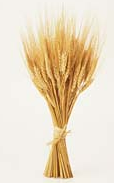Does the omer-count begin on the 16th of Nisan?
17-04-2014 - Posted by Andre Piet Today (Wednesday, April 16, 2014), it is the 16th of Nisan on the Hebrew calendar. In present-day Judaism, that is the first day of the omer-count. The day is described in Leviticus 23:9-16, as the day of the sheaf of the Firstfruits (sheaf = omer).
Today (Wednesday, April 16, 2014), it is the 16th of Nisan on the Hebrew calendar. In present-day Judaism, that is the first day of the omer-count. The day is described in Leviticus 23:9-16, as the day of the sheaf of the Firstfruits (sheaf = omer).
10 Speak to the sons of Israel and say to them, When you come into the land which I am giving to you and reap its harvest, you will bring a sheaf of the firstfruit of your harvest to the priest. 11 He will wave the sheaf before YAHWEH for acceptance on your behalf. From the MORROW AFTER THE SABBATH the priest shall wave it. (…) 15 You will count off for yourselves from MORROW AFTER THE FIRST SABBATH, from the day you bring the sheaf of the wave offering: there shall be seven flawless sabbaths. 16 Until the morrow after the seventh sabbath you shall count off fifty days…
Historically, there has been a controversy within Judaism about what “the morrow after the Sabbath,” in this case, means. One school (that of the Pharisees) taught that the Sabbath, here, relates to the 15th of Nisan, i.e., the first day of the feast of unleavened bread. After all, on this day, “no occupational work” was to be done (23:7), so that, in practice, it was considered to be a Sabbath day. If this reasoning is correct, then it is obvious that “the morrow after the Sabbath” would be the 16th of Nisan. The school of the Sadducees taught that the Sabbath, here, refers to the weekly Sabbath, so that, to the next day, no fixed date could be assigned. According to them, the day of the sheaf of the Firstfruits was, by definition, the first day of the week – a Sunday. The Sadducees were dominant in the temple service in the days of NT. Present-day, rabbinical Judaism is the spiritual heir of the Pharisaic school. Hence, the discussion about the date of the sheaf of the Firstfruits, eventually, came to favor the school of the Pharisees. However, the reading of the Sadducees has a much more solid ground. That the 15th of Nisan was considered to be a Sabbath, is correct. But in the first place, Leviticus 23 does not mention it as such. Moreover, in the list of feasts, specific dates are always given, except for the day of the sheaf of the Firstfruits and neither for the associated Feast of Weeks. No date, at all, is given for it, but instead a weekday: the morrow after the Sabbath. If the reading of the Pharisees were correct, why is it that in Lev.23, the 16th of Nisan was not simply designated as the day of the sheaf of the Firstfruits? In addition, from the day of the sheaf of the Firstfruits, one had to count seven Sabbaths, till the morrow after the seventh Sabbath, and then began the Feast of Weeks (or Pentecost, i.e. the fiftieth day). The mere fact that here, again, it speaks of “the morrow after the Sabbath” and not of a specific date, proves that it is indeed a first day of the week. Besides, why should it be necessary to count days, if there is a fixed date for it? The need to count confirms that there is no fixed date given. In other words, it is incorrect that Judaism celebrates the day of the sheaf of the Firstfruits on the 16th of Nisan. That day should be celebrated on a first day of the week. That was also the day that Jesus rose from among the dead, as the Firstfruit, “the day after de sabbat”. Not on any given Sunday, but on the first day of the omer-count. Concerning the Sadducees, we know that they, in opposition to the Pharisees, did not believe in the resurrection (Mat.22:23; Acts 23:8). But Jesus Christ, precisely, rose from among the dead (as the Firstfruit!) on the day which the Sadducees recognized as the day of the sheaf of the Firstfruits! ![]()

 English Blog
English Blog